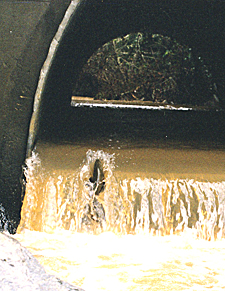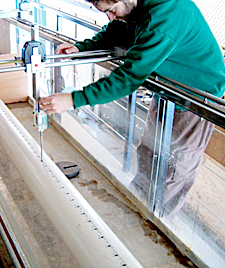
“People think of big dams on the Columbia and other major rivers when they think of problems with fish passage,” says Margaret Lang, a Humboldt State University professor of environmental resources engineering, “but it could be a two-foot culvert in someone’s backyard.”
Lang, who specializes in the science of fish passage, is a key player in the effort to restore salmon spawning runs in Humboldt County and across northern California by replacing outdated culverts.
Lang studies how culverts affect adult and juvenile salmon, and she researches new designs to make culverts more fish-friendly. Virtually every road of any significant length in Humboldt County crosses a stream or creek at some point, and all of these roads have culverts—typically large cylindrical pipes--that allow water to flow beneath the road surface.
Many of these culverts were built decades ago, before fish passage was a concern. These outdated structures are often too small in diameter or feature steep downgrades. This increases the velocity of water flowing through. For salmon, this is sort of like trying to swim up a fire hose turned on full blast. “The fish aren’t strong enough to swim against these currents,” Lang says.
Lang stresses that she does not get involved in the construction of these new culverts. That is left to government and private engineers and construction firms, who use the scientific data that Lang supplies to guide their work.

Lang and her students use computer simulations and a large manmade flume to test different culvert designs. The idea is to determine what designs best simulate the natural conditions of a creek or stream. Good culverts allow water to adequately drain through during high flows, and they eliminate bottlenecks of raging water. Ideally, they are as wide as the stream and have a gentle downward slope. “The conditions inside the culvert should be the same as in the stream during fish migration flows,” Lang says.
Salmon restoration is a large-scale endeavor throughout the region. An estimated $30 million in restoration projects have taken place in Humboldt County alone during the past two decades. Old logging roads are being removed to reduce runoff that fills waterways with sediment and interferes with spawning. Stream banks are being replanted to improve habitat. Woody debris and fallen trees are being placed in creeks to mimic natural conditions.
To date, at least 48 fish passage improvement projects have been completed in Humboldt and four other northern California counties. Many more are planned, including an effort to improve fish passage beneath the region’s highways. State transportation and fish and game officials are determining what highway culverts to replace based on a study conducted by Lang and her students. That four-year study, completed in 2005, drew up a list of the highest-priority fish passage projects on state highways in the region.
One recently completed project that resulted from Lang’s study took place on Chadd Creek near Redcrest, where a culvert built in 1964 had collapsed and cut off salmon runs.
“Her work has had a big impact in the region,” says Michael Love, a 1996 HSU graduate and former student of Lang’s who runs a Eureka firm that specializes in fish passage and stream restoration.
Lang is now studying how baffles placed in culverts can improve fish passage by creating areas of calm water—mimicking the effect of natural eddies. “That is really interesting research,” Love says. “It’s the state of the art in retrofitting culverts.”
Lang’s work could have implications for fish passage far beyond Humboldt County. Culverts have been identified as a problem for various fish species nationwide, and Love says that Lang’s students are poised to get jobs in this growing field. “Her students get a lot of hands-on experience. They measure water flows and get to see salmon jumping and trying to get through culverts.”
For Lang, the ultimate satisfaction comes with seeing a spawning run restored. Sitting in her office, she plays video footage of salmon leaping in vain to enter a culvert on a tributary of Jacoby Creek. Fish fling themselves into the torrent of water spouting from the culvert, but the raging water continually throws the fish back.
That outdated culvert has since been replaced. Seventy salmon returned to spawn in the waters upstream of that culvert the year after it was fixed. “That’s just one small tributary, three to five feet wide and one to five feet deep,” Lang says. There are hundreds of such blockages across northern California. Fixing all those culverts, Lang says, “would make a huge difference for salmon.”